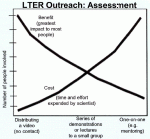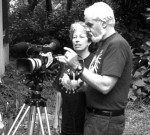The LTER Network has much to offer the public and policy makers -- information about the past, present and future of our environment.
Across the Network, LTER sites are actively engaged in extensive communications and outreach activities, representing excellent first steps toward a comprehensive effort. As LTER matures "so does the the array of opportunities and the importance of these activities" for outreach, according to the National Advisory Board review (see article, page one). And increasingly, the report adds, "a Network-wide strategy is needed." In response to the NAB recommendations, and to increasing demands on individuals at LTER sites, the Network Office is developing a Communications and Outreach plan that, through the involvement of the sites and other partners, outlines opportunities that will build upon the work already begun.
The goal of the LTER Outreach Project is to inform communities about the science conducted at their local LTER site, to brief congressional representatives on the value of LTER science, and to support and conduct education programs at all levels—from elementary school students to continuing education for adults.
In accordance with the recommendations of the NAB Report, the LTER Outreach Project will "fully realize the LTER Network concept, exploiting the many opportunities for expanded partnerships and increasing the resources needed to implement this concept. Employing aspects of communications, marketing and informal education will serve diverse audiences, informing them about the importance of the LTER science."
An important by-product of this effort will be the LTER’s endorsement of the value of Outreach as an integral component of a research program.
Elements of this plan include, but are not limited to:
- Identifying key individuals at sites and connected to partnership organizations who are interested in participating in this Network-wide effort
- Identifying the target audiences
- Developing key messages and the overall LTER ‘story'
- Identifying partners with the scientific and financial capacity to augment LTER research and outreach
- Developing tools and methods of outreach and education for each target audience
- Initiating targeted outreach to under-represented groups, taking advantage of the geographic locations of these sites (e.g., Hispanic communities surrounding the Sevilleta and Jornada sites)
- Establishing linkages to training programs for LTER scientists to become effective science communicators to many different audiences (e.g., the Aldo Leopold Leadership Program)
- Partnering with extension-type specialists who would work with LTER scientists to broadly communicate science
- Assembling a group of individuals who will agree on a timetable for implementation, a budget estimate and possible proposal writing
- Collaborating regional networks of sites to generate broader perspectives
The Network Office has created a preliminary development plan through consultation with Robert Bohanan (Outreach Program Manager, Center for Biology Education, University of Wisconsin-Madison), Kathy Fallon-Lambert (Executive Director, Hubbard Brook Research Foundation), Tish Morris (Education Coordinator, New Mexico Natural History Museum), and Rachel Maurer (University of New Mexico Office of Public Affairs).
A survey of current outreach activities at LTER sites, pulled from their Web sites, is assembled on the LTER Outreach Project Web site.
The next steps toward advancing the project are:
- Rallying a group of individuals available for participation and consultation, both at LTER sites and at partnership organizations
- Identifying target audiences
- Surveying resources currently available for the Outreach Project, through the input of the group
- Matching the available resources to the goals of the project and the needs of the Sites
- Implementation
The general goals of the Outreach Project include encouraging future scientists, developing scientifically literate citizens who can make educated decisions, and promoting the importance of long-term ecological research.
Specific goals include:
- Increasing the profile of LTER science in an effort to sustain the LTER program, as many new initiatives are the direct result of recognition beyond peer-reviewed publications
- Developing awareness of the individual’s role in a sustainable future
- Developing awareness of the process and true nature of science (funding, discovery, problem solving, etc.)
- Developing an awareness among scientific communities of the importance of integrating outreach with research programs
Target audiences include children (including under-represented minorities), NGOs and similar groups, policy makers, and other scientists.
A preliminary assessment of methods for reaching these audiences reveals many possibilities, such as:
- Single-event interactions (lectures and slide-shows presentations at schools, science fairs, museums and science centers
- Specific presentations (How to do a science fair project, How to use the WWW for ecology research, Simple experiments to do at home, What’s wrong with this picture (explaining science faux pas in movies/media), field trips, and judging a science fair
- On-going interactions (mentoring, becoming a Science Advisor to museum or science center, partnering with teachers, NGOs, and projects such as EPA’s "Adopt a Watershed")
Many human resources already exist at or near LTER sites: Informal Science Educators, school teachers, and undergraduate students such as REUs. Institutions frequently have infrastructure for coordinating and publicizing activities, including university public affairs personnel, and outreach people at local science centers and museums.
Content is abundant; LTER core research topics and themes such as biodiversity, global change, disturbance, NPP and other subjects are perfect themes for organizing outreach projects.
In addition to the brochures already produced, more and different materials will be needed to accomplish the Network Outreach Project goals. John Dennis Productions, an independent contractor, was granted funding to produce videos by, for and about the U.S. and the International LTER Networks. These videos are broad in scope, outlining details of LTER science, as well as themes, philosophies, and impressions of researchers around the world. Producer/Director John Dennis acquired considerable footage through multiple visits to LTER sites, as well as ILTER meetings. Dennis also has video taped several Schoolyard LTER sites in action in the U.S. and abroad. The audience is the general public and the film will debut at the Y2K LTER All Scientist’s Meeting, August 2000, Snowbird, Utah.
Used properly, video can add interest to presentations. The Network Office will begin producing, storing, and indexing digital video libraries for use Network-wide, similarly to the way slides are used currently. Increasing Internet bandwidth opens up possibilities for interactive websites, which can feature LTER field research as it happens. Other possibilities include informational and instructional videos and CD-ROMS for use in classrooms and presentations.
Perhaps the most difficult portion of the Outreach Project is the most important: assessing success. While counting attendance at events and conducting surveys on Web sites are helpful, the most rewarding indicator of success is direct feedback from audiences—policy makers, parents, and children. The benefits of an outreach program are difficult to isolate, but any effort to spread knowledge and sustain the legacy of LTER science is valuable.

 Enlarge this image
Enlarge this image

